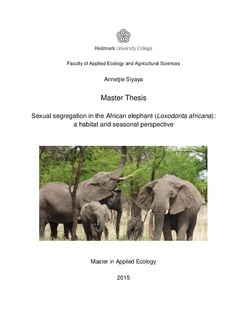| dc.description.abstract | Sexual segregation refers to when male and females of the same species live in separate groups when they are not mating. This behavior is displayed in species that are sexually dimorphic and the African elephant (Loxodonta africana) displays extreme sexual dimorphism. I studied elephants in two habitats, Serengeti and Mikumi National Parks, and during the wet and dry seasons as factors that could lead to sexual segregation. The objective of this study was to test sexual segregation based on: the body size hypothesis, scramble competition hypothesis and the activity budget hypothesis. Bull and family groups preferred to graze in the wet season as predicted, and also during the dry season. Browsing may not have been preferred by the sexes owing to abnormal rains that fell in the Serengeti a few weeks prior to fieldwork for this study. This suggests that forage type is selected in proportion to availability, irrespective of habitat type and season, and this could consequently determine whether sexes segregate. Interestingly, female groups browsed more than bull groups in the wet season implying selectivity among the female. Consistent with my predictions, overlap in plant species and plant parts browsed in the dry season between the sexes was not significant. Females incorporated a wide range of plant species in their foraging while males incorporated a wide range of plant parts. This is in support of the body size hypothesis which suggests selective feeding in terms of diet quality, among the smaller females in order to meet their nutritional demands. Males generally preferred to browse on previously impacted Acacia robusta due to their ability to tolerate chemical defenses produced by plants, owing to retention time which is directly proportional to body size. The difference in browsing height between the sexes was significant in support of the scramble competition hypothesis. The activity budget hypothesis was not supported by this study as there was no significant difference in biting rate between the sexes. Understanding of sex related feeding preferences could be relevant for management of both plant and animal species that coexist with this megaherbivore. | nb_NO |
